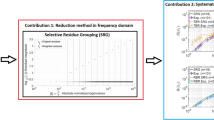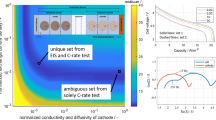Abstract
Electrochemical models are a widespread framework to simulate lithium-ion (Li-ion) batteries and to design their battery management algorithms. To obtain numerically efficient models, the polynomial approximation (PA) is one of many order reduction techniques applied to the solid-state lithium-ion (SSLi+) diffusion equation, the core of the so-called pseudo-two-dimensional electrochemical model (P2DM). Although the validity of PA is constrained to slow-varying current scenarios, many algorithms reported in the literature to estimate the state-of-charge of Li-ion cells rely on low-order PA-based dynamic models (PADMs) derived from the P2DM. Moreover, assuming that most properties of their low-order counterparts are inherited, some authors suggest that PADMs of arbitrary high order can be used to provide very accurate approximations of the state-of-charge, even under complex operating conditions. Nevertheless, to authors knowledge, in the open literature there is not a proper analysis to support such assertion. In this paper, by introducing a systematic method to derive PADMs of arbitrary order, the ability of high-order PADMs to reproduce the average and surface concentrations described by the SSLi+ diffusion equation is investigated in time and frequency domains, with the aid of classic control systems theory techniques. The main result shows that PADMs of order greater than 2 are structurally fragile as non-minimum-phase zeros as well as spurious unstable modes are induced by the PA technique, implying that high-order PADMs are not suitable for simulation or estimation purposes because of their weak internal structure.
Graphic abstract





Similar content being viewed by others
Notes
The C rate of a current (charging or discharging) in \(h^{-1}\) units is defined as the ratio of the electric current in A over the nominal capacity \(C_{nom}\) of the cell in A\(\cdot\)h.
This difference of 2 dB is established arbitrarily as a quantitative criterion to evaluate the accuracy of the PADMs.
Here order refers to truncation error of the numerical method.
References
Armand M, Tarascon JM (2008) Building better batteries. Nature 451:652–657
Chaturvedi N, Klein R, Christensen J, Ahmed J, Kojic A (2010) Algorithms for advanced battery management systems—modeling, estimation, and control challenges for lithium-ion batteries. IEEE Control Syst Mag 30:49–68
Dao TS, Vyasarayani CP, McPhee J (2012) Simplification and order reduction of lithium-ion battery model based on porous-electrode theory. J Power Sources 198:329–337
Dey S, Ayalew B, Pisu P (2015) Nonlinear robust observers for state-of-charge estimation of lithium-ion cells based on a reduced electrochemical model. IEEE Trans Control Syst Technol 23:1935–1942
Di Domenico D, Stefanopoulou A (2010) Lithium-ion battery state of charge and critical surface charge estimation using an electrochemical model-based extended Kalman filter. J Dyn Syst Meas Control 132:061302-1–061302-11. https://doi.org/10.1115/1.4002475
Doyle M, Fuller T, Newman J (1993) Modeling of galvanostatic charge and discharge of the lithium/polymer/insertion cell. J Electrochem Soc 140:1526–1533
Doyle M, Newman J (1996) Comparison of modeling predictions with experimental data from plastic lithium ion cells. J Electrochem Soc 143:1890–1903
Fang H, Wang Y, Sahinoglu Z, Wada T, Hara S (2014) State of charge estimation for lithium-ion batteries: an adaptive approach. Control Eng Pract 25:45–54
Fang H, Zhao X, Wang Y, Sahinoglu Z, Wada T, Hara S, de Callafon RA (2014) Improved adaptive state-of-charge estimation for batteries using a multi-model approach. J Power Sources 254:258–267
Forman JC, Bashash S, Stein JL, Fathy HK (2011) Reduction of an electrochemistry-based li-ion battery model via quasi-linearization and Padé approximation. J Electrochem Soc 158:A93–A101
Fuller T, Doyle M, Newman J (1994) Simulation and optimization of the dual lithium ion insertion cell. J Electrochem Soc 141:1–10
Guo M, Sikha G, White RE (2011) Single-particle model for a lithium-ion cell: thermal behavior. J Electrochem Soc 158:A122–A132
Han X, Ouyang M, Lu L, Li J (2015) Simplification of physics-based electrochemical model for lithium ion battery on electric vehicle. Part I: diffusion simplification and single particle model. J Power Sources 278:802–813
Han X, Ouyang M, Lu L, Li J (2015) Simplification of physics-based electrochemical model for lithium ion battery on electric vehicle. Part II: pseudo-two-dimensional model simplification and state of charge estimation. J Power Sources 278:814–825
Hannan M, Lipu M, Mohamed A (2017) A review of lithium-ion battery state of charge estimation and management system in electric vehicle applications: challenges and recommendations. Renew Sustain Energy Rev 78:834–854
Haran B, Popov B, White R (1998) Determination of the hydrogen diffusion coefficient in metal hydrides by impedance spectroscopy. J Power Sources 75:56–63
Hu X, Stanton S, Cai L, White R (2012) A linear time-invariant model for solid-phase diffusion in physics-based lithium ion cell models. J Power Souces 214:40–50
Hu X, Stanton S, Cai L, White R (2012) Model order reduction for solid-phase diffusion in physics-based lithium ion cell models. J Power Sources 218:212–220
Jacobsen T, West K (1995) Diffusion impedance in planar, cylindrical and spherical geometry. Electrochim Acta 40:255–262
Jokar A, Rajabloo B, Désilets M, Lacroix M (2016) Review of simplified pseudo-two-dimensional models of lithium-ion batteries. J Power Sources 327:44–55
Karden E, Ploumen S, Fricke B, Miller T, Snyder K (2007) Energy storage devices for future hybrid electric vehicles. J Power Sources 168:2–11
Kemper P, Kum D (2013) Extended single particle model of li-ion batteries towards high current applications. In: Proceedings of the 2013 IEEE vehicle power and propulsion conference (VPPC), Beijing, pp 158–163
Klein R, Chaturvedi NA, Christensen J, Ahmed J, Findeisen R, Kojic A (2010) State estimation of a reduced electrochemical model of a lithium-ion battery. In: Proceedings of the American control conference, Baltimore, pp 289–301
Klein R, Chaturvedi NA, Christensen J, Ahmed J, Findeisen R, Kojic A (2013) Electrochemical model based observer design for a lithium-ion battery. IEEE Trans Control Syst Technol 21:289–301
Lee JL, Chemistruck A, Plett GL (2012) One-dimensional physics-based reduced-order model of lithium-ion dynamics. J Power Sources 220:430–448
Lee T, Filipi Z (2011) Electrochemical Li-Ion battery modeling for control design with optimal uneven discretization. In: Proceedings of the ASME dynamic systems and control conference, Arlington, pp 493–500
Li X, Fan G, Rizzoni G, Canova M, Zhu C, Wei G (2016) A simplified multi-particle model for lithium ion batteries via a predictor-corrector strategy and quasi-linearization. Energy 116:154–169
Lukic S, Cao J, Bansal R, Rodriguez F, Emadi A (2008) Energy storage systems for automotive applications. IEEE Trans Ind Electron 55:2258–2267
Ma Y, Ru J, Yin M, Chen H, Zheng W (2016) Electrochemical modeling and parameter identification based on bacterial foraging optimization algorithm for lithium-ion batteries. J Appl Electrochem 46:1119–1131
Majdabadi MM, Farhad S, Farkhondeh M, Fraser RA, Fowler M (2015) Simplified electrochemical multi-particle model for LiFePO4 cathodes in lithium-ion batteries. J Power Sources 275:633–643
Moura S, Chaturvedi N, Krstić M (2012) PDE estimation techniques for advanced battery management systems—Part II: SOH identification. In: Proceedings of American control conference, Quebec, pp 566–571
Perez H, Dey S, Hu X, Moura S (2017) Optimal charging of li-ion batteries via a single particle model with electrolyte and thermal dynamics. J Electrochem Soc 164:A1679–A1687
Plett GL (2015) Battery modeling, Battery Managemet Systems, vol I. Artech House, Norwood
Rahimian S, Rayman S, White R (2013) Extension of physics-based single particle model for higher charge-discharge rates. J Power Souces 224:180–194
Rahman M, Anwar S, Izadian A (2016) Electrochemical model parameter identification of a lithium-ion battery using particle swarm optimization method. J Power Sources 307:86–97
Ramachandran S, Khandelwal A, Hariharan KS, Kim BC, Kim KY (2016) Rapid analysis of charging profiles of lithium ion batteries using a hybrid simplified electrochemical model. J Electrochem Soc 163:A1101–A1111
Ramadesigan V, Boovaragavan V, Pirkle JCJ, Subramanian VR (2010) Efficient reformulation of solid-phase diffusion in physics-based lithium-ion battery models. J Electrochem Soc 157:A854–A860
Ramadesigan V, Northrop PW, De S, Santhanagopalan S, Braatz RD, Subramanian VR (2012) Modeling and simulation of lithium-ion batteries from a systems engineering perspective. J Electrochem Soc 159:R31–R45
Rice RG, Do DD (1995) Applied mathematics and modeling for chemical engineers. Wiley, New York
Scrosati B, Garche J (2010) Lithium batteries: status, prospects and future. J Power Sources 195:2419–2430
Seaman A, Dao TS, McPhee J (2014) A survey of mathematics-based equivalent-circuit and electrochemical battery models for hybrid and electric vehicle suimulation. J Power Sources 256:410–423
Skeel R, Berzins M (1990) Simultaneous block diagonalization of two real symmetric matrices. SIAM J Sci Stat Comput 11:1–32
Smith K, Rahn C, Wang C (2007) Control oriented 1D electrochemical model of lithium ion battery. Energy Convers Manag 48:2565–2578
Smith K, Wang CY (2006) Solid-state diffusion limitations on pulse operation of a lithium ion cell for hybrid electric vehicles. J Power Sources 161:628–639
Smith KA, Rahn CD, Wang CY (2008) Model order reduction of 1D diffusion systems via residue grouping. J Dyn Syst Meas Control 130:011012-1–011012-8
Subramanian VR, Boovaragavan V, Diwakar VD (2007) Towards real-time simulation of physics based lithium-ion battery models. Electrochem Solid State Lett 10:A255–A260
Subramanian VR, Boovaragavan V, Ramadesigan V, Arabandi M (2009) Mathematical modeling reformulation for lithium-ion battery simulations: galvanostatic boundary conditions. J Electrochem Soc 156:A260–A271
Subramanian VR, Ritter JA, White RE (2001) Approximate solutions for galvanostatic discharge of spherical particles I. Constant diffusion coefficient. J Electrochem Soc 148:E444–E449
Subramanian VR, Tikawar VD, Tapriyal D (2005) Efficient macro-micro scale coupled modeling of batteries. J Electrochem Soc 152:A2002–A2008
Waag W, Fleischer C, Sauer DU (2014) Critical review of the methods for monitoring of lithium-ion batteries in electric and hybrid vehicles. J Power Sources 258:321–339
Wang Y, Fang H, Sahinoglu Z, Wada T, Hara S (2015) Adaptive estimation of the state of charge of lithium-ion batteries: nonlinear geometric observer approach. IEEE Trans Control Syst Technol 23:948–962
Zeng Y, Albertus P, Klein R, Chaturvedi N, Kojic A, Bazant M, Christensen J (2013) Efficient conservative numerical schemes for 1D nonlinear spherical diffusion equations with applications in battery modeling. J Electrochem Soc 160:A1565–A1571
Zhang Q, White RE (2007) Comparison of approximate solution methods for the solid phase diffusion equation in a porous electrode model. J Power Sources 165:880–886
Zuo C, Manzie C, Nešić D (2016) A framework for simplification of PDE-based lithium-ion battery models. IEEE Trans Control Syst Technol 24:1594–1609
Acknowledgements
The authors gratefully thank the financial support from PAPIIT-UNAM, Grant IN104218; and CONACYT CVU: 557079, and CVU: 229948.
Author information
Authors and Affiliations
Corresponding author
Additional information
Publisher's Note
Springer Nature remains neutral with regard to jurisdictional claims in published maps and institutional affiliations.
Rights and permissions
About this article
Cite this article
Ortiz-Ricardez, F.A., Romero-Becerril, A. & Alvarez-Icaza, L. Hard limitations of polynomial approximations for reduced-order models of lithium-ion cells. J Appl Electrochem 50, 343–354 (2020). https://doi.org/10.1007/s10800-019-01395-y
Received:
Accepted:
Published:
Issue Date:
DOI: https://doi.org/10.1007/s10800-019-01395-y




